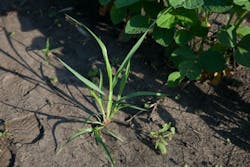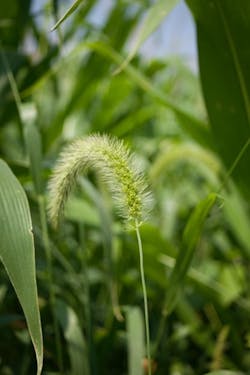Foxtail is an annual grassy weed capable of thriving in a variety of soils and climates throughout the United States. As this persistent pest can quickly become an issue for utility vegetation managers — particularly throughout substations — knowing how to identify and control it effectively is essential to ensuring safety throughout treatment sites across the country.
Why is Foxtail a Problem?
Foxtail (Hordeum jubatum) is a grass-like weed that can grow up to 4 feet tall, which poses a variety of issues throughout utility substations, including:
· Threatens the integrity of utility infrastructure
· Poses tripping and falling hazards for workers
· Harbors insects and small animals near electrical equipment
· Limits site accessibility and inspection capabilities for work-zone personnel
Once germinated, foxtail can reach maturity and develop seed within 40 days, making prompt identification and control essential to the success of utility vegetation management programs.
What Does Foxtail Look Like?
As a relentless weed that commonly develops in moist or dry soils and various climate conditions, foxtail is capable of growing in most geographies across the country. Aside from Hawaii and most of the Southeast, foxtail is reported to thrive in 43 states, existing year-round in most western territories.
While three different species of foxtail exist (green, yellow and giant), each can be distinguished by unique characteristics:
Leaves
The leaves of giant foxtail can measure up to 15 inches long and commonly feature dense hair on the upper surface. Comparatively, green and yellow foxtail measure no more than 12 inches in length. Yellow foxtail usually displays sparse hairs on the surface of cobweb-like yellowish-white leaves, while the leaves of green foxtail species feature a smoother surface with no hairs at all.
The leaves of green foxtail often feature a smooth surface and can measure up to 1 foot long.
Compared with yellow foxtail, which features a flat stem and a reddish tint at its base, green and giant foxtail feature round stems. The stems of green foxtails are usually lined with small hairs; the stems of giant foxtail are typically smooth.
Yellow foxtail features flat stems and a reddish tint featured at its base.
Seed Heads
Green and yellow foxtail feature seed heads that are more erect and measure 2 to 5 inches long. Giant foxtail features seed heads that tend to droop and grow to lengths of 3 to 8 inches. The color of green and giant foxtail seed heads is normally green; yellow foxtail features yellow seed heads.
As a distinguishing feature of each foxtail species, the seed head is the plant’s sole source of reproduction, with anywhere from 20 to 70 seeds held within each head. That’s why it is best for vegetation managers to identify and control foxtail plants before seed heads develop in the late spring and early summer.
Unlike the shorter and erect seed heads of green and yellow foxtail, the seed heads of giant foxtail usually droop and measure up to 8 inches long.
How to Control Foxtail Effectively
Vegetation managers have used glyphosate and other nonselective herbicides to control foxtail in the past. However, weed resistance can be a common issue for vegetation management practitioners — and foxtail is no exception. Even the most commonly used herbicide products falter in performance over time, which is why it’s important for vegetation managers to introduce different modes of action that can enhance resistance management.
Piper® EZ herbicide, a new suspension concentrate liquid formulation offered through Corteva Agriscience authorized distributors, contains two active ingredients with differing modes of action to enhance the control of weeds that have grown tolerant of other herbicide products. At a use rate of 16 to 20 fluid ounces per acre, Piper EZ can be used to control foxtail, as well as other select grasses and broadleaf weeds, for total vegetation control on substations across the country.
In addition to providing preemergence control, Piper EZ and tank-mix partners, such as TerraVue® herbicide, can provide postemergence control after select grasses and broadleaf weeds have emerged earlier in the year. As an excellent tank-mix solution in cases where complete vegetation control is needed, Piper EZ also is recommended for total vegetation control programs on a variety of noncrop use sites, including roadsides, railroads and airports.
For more information regarding Piper EZ and the application flexibility it can provide to your vegetation management program, click here.
™ ® Trademarks of Corteva Agriscience and its affiliated companies. Piper® is a trademark of Valent U.S.A. LLC. Under normal field conditions, TerraVue® is nonvolatile. TerraVue has no grazing or haying restrictions for any class of livestock, including lactating dairy cows, horses (including lactating mares) and meat animals prior to slaughter. Label precautions apply to forage treated with TerraVue and to manure and urine from animals that have consumed treated forage. Piper EZ and TerraVue are not registered for sale or use in all states. Contact your state pesticide regulatory agency to determine if a product is registered for sale or use in your state. Consult the label for full details. Always read and follow label directions.
Sponsored By:






